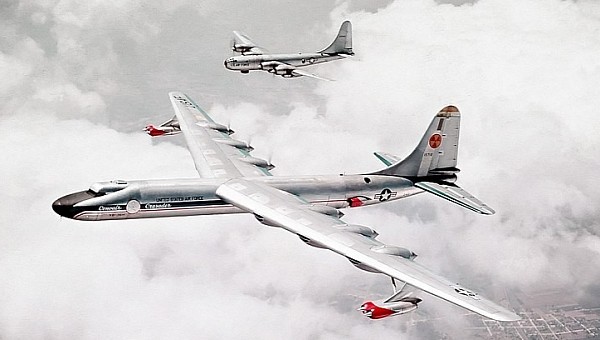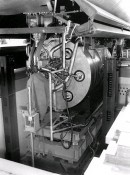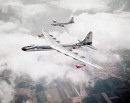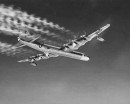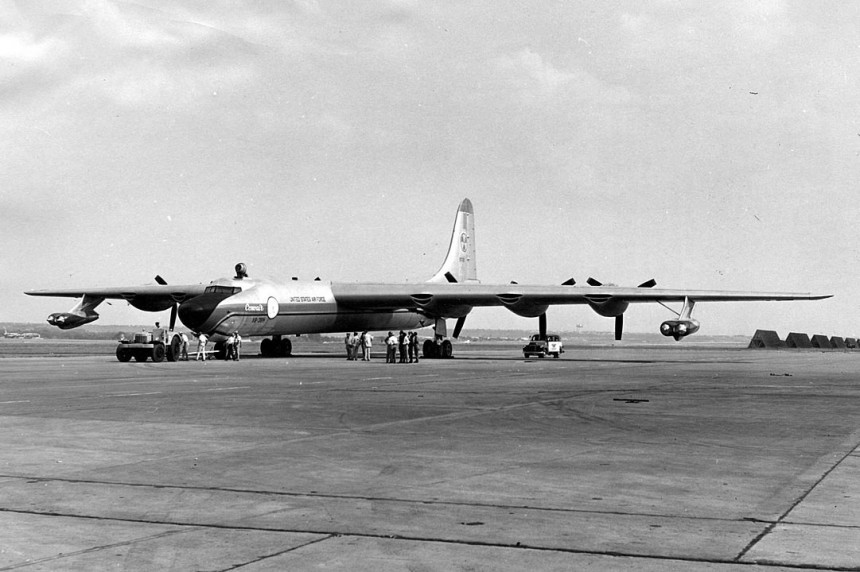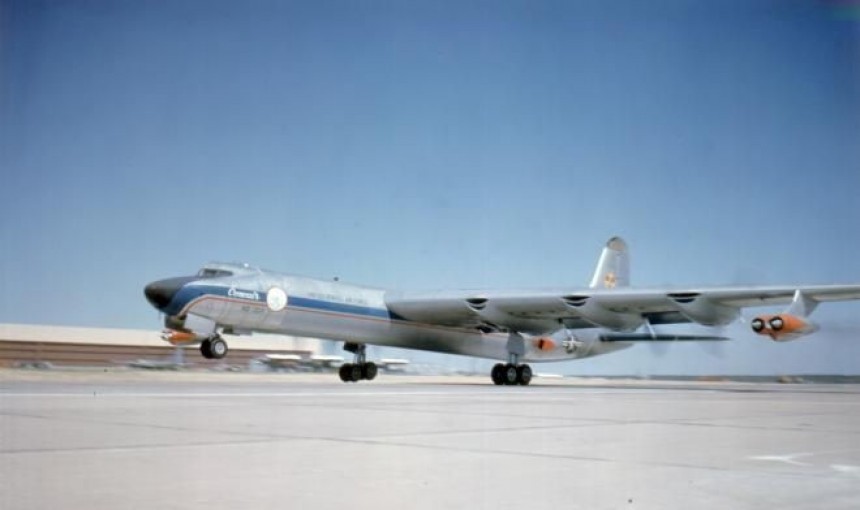Only a few airplanes could be pointed to and said in confidence were designed by an absolute mad lad. But among these names, one stands out as being especially bizarre, bonkers, and certifiably loony tunes. Say hello to the Convair NB-36, the B-36 Peacemaker's spicier, more radioactive cousin.
The impetus for the NB-36's development is one rooted in the atomic era of the 1950s to late 1960s. A time when the civilian and military sectors in the United States firmly believed nuclear energy was the path forward for humanity and acted accordingly. Everything from proposals for nuclear airplanes, trains, and even Ford's Nucleon concept car resulted from this line of thinking.
With this in mind, it at least makes rational sense that the United States Air Force figured a nuclear fission-power aircraft would be inevitable. The most practical means of creating a nuclear airplane engine would be to replace the "combustion" elements inside a turbojet's combustion chamber and replace it with a nuclear reactor undergoing critical fission. Nuclear rocket engines also work on this principle.
But before this could be done, the Air Force needed to determine if a nuclear reactor could operate inside an aircraft in the first place. This was the question the Aircraft Nuclear Program (ANP) and the later Nuclear Energy for the Propulsion of Aircraft (NEPA) attempted to answer. The program began in May 1946, less than a year after the first use of nuclear weapons in a battle setting.
The program was transferred U.S. Atomic Energy Commission in 1951. By that time, a formal proposal was submitted to the Pentagon. This proposal listed the Convair company of San Diego, California, as the chief design team for a novel nuclear-powered military plane. Dubbed the X-6, it wouldn't take long to find a testbed for such a machine.
The Convair B-36 Peacemaker was a landmark airplane, even without its red-headed nuclear step-sibling adding to its mystique. At 162 feet (49.40 m) long and with a 230-foot (70.10 m) wingspan, no piston-engined military plane would ever come close to matching the Peacemaker's insane dimensions. The maximum takeoff load rating of 410,000 lbs (185,973 kg) is pretty impressive as well, at least for its day.
The B-36's airframe would need every bit of that lifting power to haul the payload its nuclear relative carried at all times. In 1952, it was decided a tornado damaged a B-36 stationed at Carswell Air Force Base in Texas would be selected as the first and only platform for the NB-36H. Or, as its operating crews christened it, the Crusader.
First flown in September 1955, the NB-36H carried a roughly one-megawatt reactor with an unspecified nuclear isotope as its main reactor fuel. This isotope, most likely Uranium-235, was mixed with what's known as a moderator material. I.e., a substance, usually graphite, that's added to radioactive material to keep neutrons flung from fission reactions stable. Thus, limiting the chance of a meltdown. These fuel rods were arranged into a circle formation to create an active fission reactor core.
This reactor was housed inside the NB-36's cavern of a weapons bay in flight. While on the ground, the reactor lowered via an internal pully down into the lead-shielded containment area where the old Peacemaker's bomb bay used to sit. The NB-36 was powered by six massive Pratt & Whitney R-4360 28-cylinder radial piston engines flanked on either side by four General Electric J47 turbojet engines with two on either wing tip.
This made for a top speed of around 420 mph (676 kph) and a service ceiling of 40,000 feet (12,200 m). Frankly, nobody should feel safe with this thing flying overhead, even if it was in Low Earth Orbit. Though the reactor itself didn't have to power so much as a toaster, it did at least demonstrate a nuclear reactor could operate inside an aircraft without much trouble.
Over a series of 215 flight hours and 47 tests, 89 of these total hours were flown with the NB-36's reactor operation. Somehow, by some miracle, an ecological disaster did not occur during any of these test flights. Although if a crash had occurred, it was the job of a team of marines trailing behind in another aircraft to parachute down and secure the sight.
If you thought, that sounded like a one-way mission, that's because it probably would have been. If you've ever heard about the horrors that happened to the cleanup crew from Chornobyl, imagine that, plus a whole lot of airplane wreckage to sift through. Hilariously, the NB-36 was the only aircraft in the USAF's fleet that had a direct telephone line to the President integrated into the cockpit. Just in case something did go horrifically wrong.
As the Husk Kit YouTube channel once said of the NB-36 in their Ten Worst American Aircraft Ever Built video, "imagine taking that call." We couldn't agree more on that sentiment. Thankfully, the U.S. Air Force gained the good sense to realize the NB-36 was more trouble than it was worth. The program was canceled by the Kennedy administration soon after it took office in 1961, and the radioactive elements of the single airframe were buried.
No word on if there were also any old Atari cartridges buried around the same area. However, it would be poetic justice if the remains of the NB-36 found themselves surrounded by copies of E.T. for the Atari 2600, another item most notable for its failure and then winding up in an impromptu landfill.
Check back soon for more from Celebration Month 22 here on autoevolution.
With this in mind, it at least makes rational sense that the United States Air Force figured a nuclear fission-power aircraft would be inevitable. The most practical means of creating a nuclear airplane engine would be to replace the "combustion" elements inside a turbojet's combustion chamber and replace it with a nuclear reactor undergoing critical fission. Nuclear rocket engines also work on this principle.
But before this could be done, the Air Force needed to determine if a nuclear reactor could operate inside an aircraft in the first place. This was the question the Aircraft Nuclear Program (ANP) and the later Nuclear Energy for the Propulsion of Aircraft (NEPA) attempted to answer. The program began in May 1946, less than a year after the first use of nuclear weapons in a battle setting.
The program was transferred U.S. Atomic Energy Commission in 1951. By that time, a formal proposal was submitted to the Pentagon. This proposal listed the Convair company of San Diego, California, as the chief design team for a novel nuclear-powered military plane. Dubbed the X-6, it wouldn't take long to find a testbed for such a machine.
The B-36's airframe would need every bit of that lifting power to haul the payload its nuclear relative carried at all times. In 1952, it was decided a tornado damaged a B-36 stationed at Carswell Air Force Base in Texas would be selected as the first and only platform for the NB-36H. Or, as its operating crews christened it, the Crusader.
First flown in September 1955, the NB-36H carried a roughly one-megawatt reactor with an unspecified nuclear isotope as its main reactor fuel. This isotope, most likely Uranium-235, was mixed with what's known as a moderator material. I.e., a substance, usually graphite, that's added to radioactive material to keep neutrons flung from fission reactions stable. Thus, limiting the chance of a meltdown. These fuel rods were arranged into a circle formation to create an active fission reactor core.
This reactor was housed inside the NB-36's cavern of a weapons bay in flight. While on the ground, the reactor lowered via an internal pully down into the lead-shielded containment area where the old Peacemaker's bomb bay used to sit. The NB-36 was powered by six massive Pratt & Whitney R-4360 28-cylinder radial piston engines flanked on either side by four General Electric J47 turbojet engines with two on either wing tip.
Over a series of 215 flight hours and 47 tests, 89 of these total hours were flown with the NB-36's reactor operation. Somehow, by some miracle, an ecological disaster did not occur during any of these test flights. Although if a crash had occurred, it was the job of a team of marines trailing behind in another aircraft to parachute down and secure the sight.
If you thought, that sounded like a one-way mission, that's because it probably would have been. If you've ever heard about the horrors that happened to the cleanup crew from Chornobyl, imagine that, plus a whole lot of airplane wreckage to sift through. Hilariously, the NB-36 was the only aircraft in the USAF's fleet that had a direct telephone line to the President integrated into the cockpit. Just in case something did go horrifically wrong.
As the Husk Kit YouTube channel once said of the NB-36 in their Ten Worst American Aircraft Ever Built video, "imagine taking that call." We couldn't agree more on that sentiment. Thankfully, the U.S. Air Force gained the good sense to realize the NB-36 was more trouble than it was worth. The program was canceled by the Kennedy administration soon after it took office in 1961, and the radioactive elements of the single airframe were buried.
Check back soon for more from Celebration Month 22 here on autoevolution.
